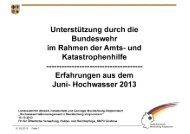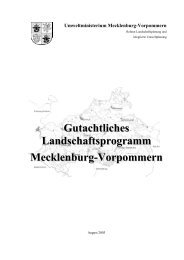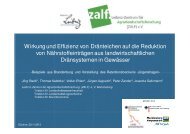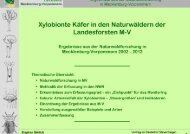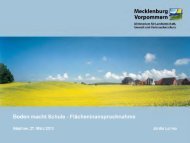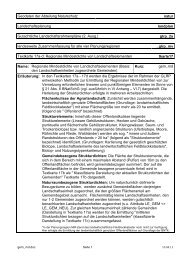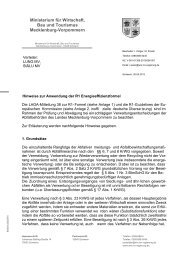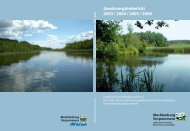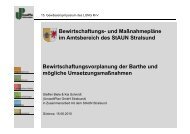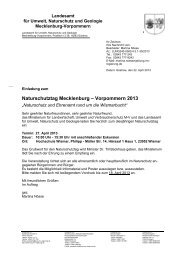Rote Liste der Moose - Landesamt für Umwelt, Naturschutz und ...
Rote Liste der Moose - Landesamt für Umwelt, Naturschutz und ...
Rote Liste der Moose - Landesamt für Umwelt, Naturschutz und ...
Erfolgreiche ePaper selbst erstellen
Machen Sie aus Ihren PDF Publikationen ein blätterbares Flipbook mit unserer einzigartigen Google optimierten e-Paper Software.
59<br />
FUKAREK, F. (1985): <strong>Rote</strong> <strong>Liste</strong> <strong>der</strong> verschw<strong>und</strong>enen <strong>und</strong> gefährdeten Höheren<br />
Pflanzen von Mecklenburg. 3. Fassung. – Bot. R<strong>und</strong>br. Bez. Neubrandenburg 16,<br />
3-44, Waren/M.<br />
FUKAREK, F. & HENKER, H. (1983): Neue kritische Flora von Mecklenburg (1. Teil). –<br />
Arch. Fre<strong>und</strong>e Naturgesch. Mecklenb. 23: 28–133, Rostock.<br />
FUKAREK, F. & HENKER, H. (2006): Flora von Mecklenburg-Vorpommern – Farn- <strong>und</strong><br />
Blütenpflanzen. – Herausgegeben von Heinz Henker <strong>und</strong> Christian Berg, 428 S.<br />
Weissdorn-Verlag Jena.<br />
GAGHARADJEDAGHI, B., HEIMANN, R., LENZ, K., MARTIN, C., PIEPER, V., SCHULZ, A.,<br />
VAHABZADEH, A., FINCK, P., RIECKEN, U. (2004): Verbreitung <strong>und</strong> Gefährdung<br />
schutzwürdiger Landschaften in Deutschland – Natur <strong>und</strong> Landschaft 79: 71–81.<br />
GÄRDENFORS, U., HILTON-TAYLOR, C., MACE, G. M., RODRÍGUEZ, J. P. (2001): The application<br />
of the IUCN Red List Criteria at regional levels. – Conserv. Biol. 15, 1206–1212.<br />
GARLETTS, H., KROTT, M. (2002): Erfolg <strong>und</strong> Versagen roter <strong>Liste</strong>n – wann ist <strong>der</strong>en<br />
Einsatz ratsam? – Natur <strong>und</strong> Landschaft 77, 110–115.<br />
GRAMMONT DE, P. C., CUARON, A. D. (2006): An evolution on threatened species categorization<br />
systems used on the American continent. – Conserv. Biol. 20: 14–27.<br />
HALLINGBÄCK, T., HODGETTS, N. G. [ed.] (2000): Mosses, Liverworts, and Hornworts:<br />
Status Survey and Conservation Action Plan for Bryophytes. – IUCN/SSC<br />
Bryophyte Specialist Group, International Union for Conservation of Nature and<br />
Natural Resources, Sveriges lantbruksuniversitet, 106 p.<br />
HARTLEY, S., KUNIN, W. E. (2003): Scale dependency of rarity, extinction risk and conservation<br />
priority. – Conserv. Biol. 17: 1559–1570.<br />
HEILMANN-CLAUSEN, J., AUDE, E., CHRISTENSEN, M. (2005): Cryptogam communities on<br />
decaying deciduous wood – does tree species diversity matter? – Biodiv.<br />
Conserv. 14: 2061–2078.<br />
INGERPUU, N., VELLAK, K., KUKK, T., PÄRTEL, M. (2001): Bryophyte and vascular plant<br />
species richness in boreo-nemoral moist forests and mires. – Biodiv. Conserv.10:<br />
2153–2166.<br />
IUCN – [INTERNATIONAL UNION FOR CONSERVATION OF NATURE AND NATURAL RESOURCES, ed.]<br />
(2001): Red List Categories and Criteria. Version 3.1. – II + 30 S., IUCN, Gland.<br />
IUCN (2003): Guidelines for Application of IUCN Red List Criteria at Regional Levels:<br />
Version 3.0. IUCN Species Survival Commission. Gland – Cambridge. ii + 26 S.<br />
IUCN – [STANDARDS AND PETITIONS WORKING GROUP, ed.] (2006): Guidelines for Using<br />
the IUCN Red List Categories and Criteria. Version 6.2. Prepared by the<br />
Standards and Petitions Working Group of the IUCN SSC Biodiversity<br />
Assessments Sub-Committee in December 2006. http://app.iucn.org/webfiles/doc/SSC/RedList/RedListGuidelines.pdf.



